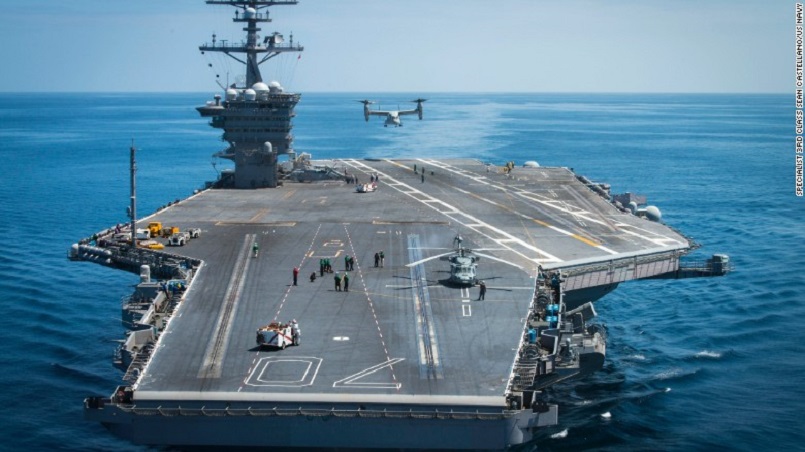
The US Navy is moving the USS Ronald Reagan aircraft carrier to the Korean Peninsula where it will conduct dual-carrier training exercises with the USS Carl Vinson amid heightened tensions in the region, two defense officials told CNN.
The move comes just days after North Korea demonstrated a significant leap forward in their missile program after launching a projectile that achieved "successful" controlled reentry into the Earth's lower atmosphere rather than falling back to the surface, according to a preliminary US intelligence analysis, two US officials tell CNN.
The USS Ronald Reagan departed for the Korean Peninsula on Tuesday after completing a maintenance period and sea trials in its homeport of Yokosuka, Japan, according to the Navy.
"Coming out of a long in-port maintenance period we have to ensure that Ronald Reagan and the remainder of the strike group are integrated properly as we move forward," Rear Adm. Charles Williams said in a press release.
Once it arrives in the region, the carrier will conduct a variety of training exercises but primarily focus on certifying its ability to safely launch and recover aircraft, the Navy said. Defense officials would not comment on long the two carriers would be there, but ultimately the Reagan is expected to replace the Vinson in the region once its deployment ends.
The 1,092-foot Reagan, a Nimitz-class carrier, has a crew of 4,539 and is equipped with roughly 60 aircraft, according to the Navy. It was commissioned in 2003 and cost about $8.5 billion.
The USS Carl Vinson, also a Nimitz-class carrier, arrived at the Korean Peninsula late last month as a show of force in advance of a long-anticipated sixth nuclear test from the North Korean government.
While North Korea has yet to carry out that nuclear test, it did launch a Hwasong-12 missile that achieved an altitude of more than 2,100 kilometers (1,300 miles) on Sunday, according to the North Koreans, the highest launch to date in their missile test program.
Pyongyang said the test was "aimed at verifying the tactical and technological specifications of the newly developed ballistic rocket capable of carrying a large-size heavy nuclear warhead," according to the state-run Korean Central News Agency.
After the test, North Korea warned the United States not to provoke it, saying the "US mainland and Pacific operations" are within range of North Korean missiles.
KCNA said the test showed North Korea "has all powerful means for retaliatory strike" should Washington take any military action to stop its nuclear weapons program.
Tensions have rapidly escalated on the Korean Peninsula since US President Donald Trump declared in early April he would be prepared to act "unilaterally" against Pyongyang -- and North Korea has engaged in a series of military drills and test launches.
China, North Korea's longtime ally, has called on Pyongyang to stop its nuclear program while calling on the US to stop military drills and deployments in the region, which North Korea sees as threatening its security.
Russian President Vladimir Putin weighed in after Sunday's missile test, saying that while Moscow did not support Pyongyang's nuclear ambitions, "intimidating (North Korea) is unacceptable."
Putin's comments drew criticism from US Ambassador to the United Nations Nikki Haley, who said Russia had it "all wrong."
"What about North Korea intimidating us?" Haley said.
Analysts said Pyongyang's latest missile test does give Washington something to worry about.
They said the test showed the missile could reach the US Pacific territory of Guam, home to Andersen Air Force Base, through which the US rotates heavy bombers, including B-1s, B-2s and B-52s.
While North Korea's arsenal of missiles is becoming clearer, there is less certainty about how developed its nuclear program is.
To actually deliver such a missile, Pyongyang would have to have advanced technology in both miniaturizing its nuclear weapons as well as in protecting a nuclear warhead from being destroyed upon reentry into the Earth's atmosphere.
